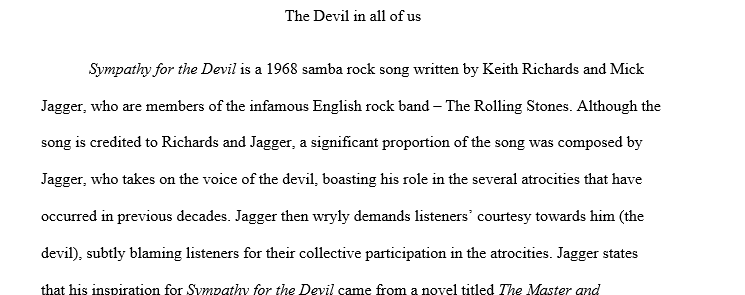Narrative Song Analysis
Compose a formal essay interpreting the themes of a narrative song. You will need a song that has a primary theme and one or two secondary themes.
Requirements:
- Be able to tell which song you are using on Wednesday
- Typed in the basic MLA format
- 1-2 scholarly sources as well as the primary source
- Includes a Works Cited page
- 750-1000 words in length
- Due on Friday, March 27 by 11:59 PM.
Rubric:
15% Introduction: You establish a context for the significance of your thesis in regards to the literary work as a whole. How does your argument contribute to understanding the author’s major literary/thematic concerns? What can other readers learn from your analysis? How does your analysis/critique fit in with other critical responses of the author/literary work?
15% Thesis: You state in 1-2 sentences your main idea. The thesis is the culmination of your introduction.
30% Organization: Your essay should follow that of a typical literary critique:
Since your focus must be on analyzing some literary motif, theme, or a combination of a literary elements (such as symbolism, character, setting, etc.), your essay must contain well-structured supporting paragraphs that contain a topic sentence, quotes from the primary text, an explanation/discussion of the significance of the quotes you use in relation to your thesis, quotes from secondary sources, and a concluding sentence or two that situates the entire paragraph in relation to the thesis. Your thesis will focus on some kind of critical analysis of the primary text, so your supporting paragraphs should be organized around each of the quotes you use, explaining the significance of the quotes and why (or how) transitions and at least six (or more) sentences.
10% Conclusion:No matter which option you choose, you want a conclusion that avoids summarizing what you’ve just said. You also don’t want to say, “In conclusion…” Your aim in a conclusion is to place the discussion in a larger context. For example, how might your critical analysis of a literary character relate to the other characters in a work? How might your thesis be applied to other aspects of the text, say for example, the setting or symbolism?
20% Grammar and Mechanics: Your paper avoids basic grammar mistakes, such as dropped fragments, run-ons, dropped apostrophes in possessives, subject/verb agreement, arbitrary tense switches, etc. The paper demonstrates a commitment to proofreading by avoiding easy-to-catch typos and word mistakes (effect for affect, for example).
10% Presentation: Your paper meets the minimum length criteria of 750 words and typed with a creative title. The paper is required to be in the MLA format, using the primary source, 1-2 scholarly secondary sources, in-text citations, and a works cited page.
The following tips might be helpful in your song analysis.
How to Write a Song Analysis for English Class
Kori Morgan
Listening to your favorite music might be an enjoyable pastime, but analyzing a song lets you apply what you’re learning in English class to a favorite composition. Figurative language, tone and theme are just a few literary devices you can practice identifying as you write about music. By analyzing these elements, you can gain an greater appreciation for the practical application of the tools of English to songwriting.
Select an original, meaningful song for your paper topic. Consider the emotional depth of the lyrics, the themes and issues it introduces and its creative use of language as you choose a song to write about. For example, “Imagine” by John Lennon, which speculates about what a world full of peace would look like, presents a strong message about countering the effects of violence and spiritual conflict in the world.
Listen to the song with the lyrics in front of you. As you play the song, underline or highlight important lines and phrases that contribute to its meaning, as well as any personal thoughts or responses that come to mind. These reactions can help you shape the analysis of your song when you begin to write.
Introduce your song in the essay by giving some historical background about it, including the songwriter, year and any events that that shaped its creation. For example, “The Rising” by Bruce Springsteen showcases the resiliency of Americans after the terrorist attacks of Sept. 11, 2001. Describing this context would be a good way to introduce readers to the song and its theme of survival.
Analyze the lyrics by examining figurative language, phrases that describe something by comparing it to something else. In “The Sound of Silence,” for example, Simon and Garfunkel use personification, which gives emotional characteristics to an object, animal or idea. By addressing the song to the “darkness” of nighttime, they emphasize the song’s themes of loneliness and isolation. You can also write about the use of rhyme, repetition and other sound devices. In “Bleeding Me” by Metallica, the speaker uses repeated lines such as “I’m digging my way” and “This thorn in my side” to show his struggle in breaking away from addiction.
Analyze the song’s use of musical arrangements. Think about how the song’s choice of a major or minor key, dominant instruments and texture relate to the lyrics and theme and create a specific mood. For example, the minor piano chords and driving drumbeats of Adele’s “Set Fire to the Rain” illustrate the speaker’s desolation after the end of a bitter relationship.
Write a conclusion that emphasizes the main theme of the song. If you’re writing about Christina Aguilera’s “Beautiful,” for example, you might say that the song encourages people who have been bullied to recognize and celebrate their uniqueness rather than let people’s words hurt them. Draw your paper together in a way that shows how the song’s lyrical and musical elements illustrate this message.
chosen song is: Rolling Stones -Sympathy for the devil
MLA
905 Words
